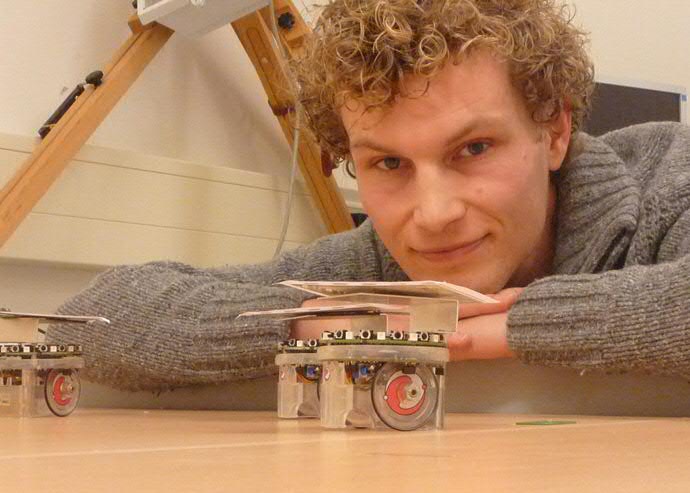Virtual spring keeps robots in formation

Robots can work together in formation thanks to a virtual spring consisting of mathematical algorithms. The primary application is to control robots for dike inspections, but the spring can also enable satellites to fly in formation. PhD student Ewoud Vos from the Engineering and Technology Institute Groningen (ENTEG) and the Johann Bernoulli Institute for Mathematics and Computer Science (JBI) describes the development of the algorithms in his PhD thesis, which he will defend on 20 February 2015 at the University of Groningen.
What is the best way to inspect the 17,000 kilometres of dikes in the Netherlands, including from the inside? Although human inspectors can see a lot, they cannot see what is going on beneath the surface of a dike. However, robots fitted with the right sensors can. Ideally, they would patrol the dikes autonomously in formation, taking all the necessary measurements along the way.
Regroup unaided
This was the basic plan devised by industrial engineer Ewoud Vos when he started his research in 2010. A fellow PhD student from the University of Twente built the robot, while he designed the mathematics that would form its brain. ‘We wanted to build a system without central control. Each robot would only communicate with the robots next to it. The formation has to be able to regroup unaided in the event of a fault or breakdown’, explains Vos.
Swarm of tiny robots
This is what is known as a multi-agent system, a swarm of tiny robots that work together. Over the last ten years, a lot of serious research has been carried out into controlling multi-agent systems. Control of the robots involves simplifying them so that they can be treated as linear systems or points. ‘In reality, these systems are much more complex and non-linear’, continues Vos. For example, a wheeled robot cannot move sideways. A simplified model does not know this, so a robot can get stuck while moving around.
Virtual spring
The mathematical approach used by Vos is known as the port-Hamiltonian framework. It allowed him to regulate the distance between the various robots using a physical structure, in this case a virtual spring. When the robots get too close to each other, the springs push them apart; when they are too far apart, the springs pull them back into formation.
Not strongly simplified
The robot models did not need to be strongly simplified to apply the mathematical algorithms that describe the springs. In addition, Vos was able to use the force exerted on the robots by the virtual springs to provide the mathematical proof that his control system would not malfunction. ‘This is the tricky part for other control systems; it can only be proved in strongly simplified models, which then need more thorough testing in practice.’ The strategy used by Vos builds on work carried out by his supervisor, University of Groningen Professor of Mathematics Arjan van der Schaft.
Self-driving cars
According to his primary supervisor, Jacquelien Scherpen, Professor of Discrete Technology and Production Automation and Director of ENTEG, Vos’s virtual springs can be put to various uses. ‘They could be used for formation flying of satellites, for example, and the system would be perfect for self-driving cars. A virtual spring between the cars in front of and behind you would allow us to drive on the motorways in convoy without colliding.’
Collaboration
Ewoud Vos will defend his thesis at 11 a.m. on 20 February in the Aula of the Academy Building. His thesis is entitled ‘Formation Control in the port-Hamiltonian framework’. This research was part of the Autonomous Sensor SYStems (ASSYS) Perspective programme being run by the STW technology foundation, and Vos worked on it in collaboration with the University of Twente. Other partners include the FloodControl IJkdijk, the Netherlands Organization for Applied Scientific Research (TNO), the European Space Agency (ESA) and the Netherlands Institute for Space Research (SRON).
Contact:
Ewoud Vos, Jacquelien Scherpen, Arjan van der Schaft.
| Last modified: | 10 June 2022 08.14 a.m. |
More news
-
03 April 2025
IMChip and MimeCure in top 10 of the national Academic Startup Competition
Prof. Tamalika Banerjee’s startup IMChip and Prof. Erik Frijlink and Dr. Luke van der Koog’s startup MimeCure have made it into the top 10 of the national Academic Startup Competition.
-
01 April 2025
NSC’s electoral reform plan may have unwanted consequences
The new voting system, proposed by minister Uitermark, could jeopardize the fundamental principle of proportional representation, says Davide Grossi, Professor of Collective Decision Making and Computation at the University of Groningen
-
01 April 2025
'Diversity leads to better science'
In addition to her biological research on ageing, Hannah Dugdale also studies disparities relating to diversity in science. Thanks to the latter, she is one of the two 2024 laureates of the Athena Award, an NWO prize for successful and inspiring...
